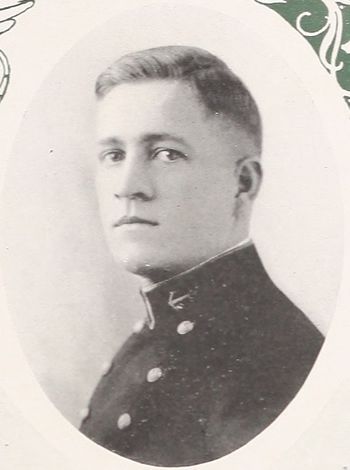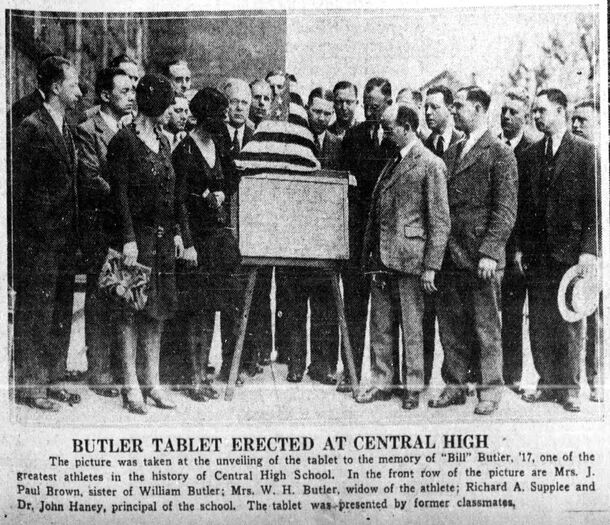WILLIAM BUTLER, JR., LT, USN
William Butler, Jr. '20
Lucky Bag
From the 1920 Lucky Bag:
William Butler, Jr.
Philadelphia, Pennsylvania
"Bill" "Butts" "Lather
W-E-L-L! Say, guy, are you gonna let 'em get away with it?" And a ponderously laden ship making heavy weather of it heaves into view around the corner. That's "Bill."
"Bill" joined us early in June fresh from Philadelphia where he won all the laurels that a man could wish for at Central High. After he was fully acclimated "Bill" began to shoot sparks and made things hum—for himself as well as the Duty Officers.
"Leady" showed us what football meant when we started to clean up the big teams in the fall. He wears an "N" with three years qualification now in proof thereof.
"Bill" always has had a running fight with the Academic Department and was almost swamped by English Plebe year. "Bill' " whole time has been taken up with football, Eddy Ewen, Bill Francis and a good time.
He 's famous for his weekly boxes from home and his smile.
Women never bothered him much until Christmas, Youngster year, and then it took a month on the Reina to convince him of the error of his ways.
"Bill" is built more like a good old Navy coal scow than a clipper ship, but you can't sink him. And there's one big thing that you can say about "Bill," he hasn't an enemy and every man is his friend.
"Dog-gone—I've gotta bone."
Honors: Clean Sleeve; Football 4, 3, 1
The Class of 1920 was graduated in June 1919 due to World War I. The entirety of 2nd class (junior) year was removed from the curriculum.

William Butler, Jr.
Philadelphia, Pennsylvania
"Bill" "Butts" "Lather
W-E-L-L! Say, guy, are you gonna let 'em get away with it?" And a ponderously laden ship making heavy weather of it heaves into view around the corner. That's "Bill."
"Bill" joined us early in June fresh from Philadelphia where he won all the laurels that a man could wish for at Central High. After he was fully acclimated "Bill" began to shoot sparks and made things hum—for himself as well as the Duty Officers.
"Leady" showed us what football meant when we started to clean up the big teams in the fall. He wears an "N" with three years qualification now in proof thereof.
"Bill" always has had a running fight with the Academic Department and was almost swamped by English Plebe year. "Bill' " whole time has been taken up with football, Eddy Ewen, Bill Francis and a good time.
He 's famous for his weekly boxes from home and his smile.
Women never bothered him much until Christmas, Youngster year, and then it took a month on the Reina to convince him of the error of his ways.
"Bill" is built more like a good old Navy coal scow than a clipper ship, but you can't sink him. And there's one big thing that you can say about "Bill," he hasn't an enemy and every man is his friend.
"Dog-gone—I've gotta bone."
Honors: Clean Sleeve; Football 4, 3, 1
The Class of 1920 was graduated in June 1919 due to World War I. The entirety of 2nd class (junior) year was removed from the curriculum.
Loss
From Providence Journal “Navy Fliers Fall To Death In Bay”, July 3, 1928, Page 1, via New England Aviation History:
On July 2, 1928, Commander Thalbert N. Alford, USN, was piloting a Vought O2U Corsair over Newport Harbor. Lieutenant Commander William Butler Jr. was aboard as an observer.
Commander Alford was doing some stunt flying, going through a series of loops and rolls 5000 feet over Newport, to the delight of onlookers on the ground. After the plane made three successive loops, it suddenly went into a spinning dive and slammed nose first into the water. Butler managed to free himself and floated to the surface, but Commander Alford went down with the aircraft.
Crewmen from several nearby naval vessels immediately launched boats and raced towards the scene. The first to arrive was a boat from the U.S.S. Antares with the ship’s doctor aboard.
Lieutenant Commander Butler was plucked from the water and rushed to Newport Naval Hospital where he died shortly afterwards. His injuries were severe, but he reportedly maintained consciousness up until about five minutes before his death. At his bedside were his wife Adelle, and three officers from the U.S.S. Wright who would later make up the board of inquest. At one point he told the men, “They should not allow such planes to be used for stunting.”
Meanwhile recovery efforts for the aircraft and the body of Commander Alford were taking place. The navy tug Bob-o-link successfully hauled the plane to the surface. Commander Alford was found still strapped in the cockpit, dead from the crushing force of the impact and not from drowning.
Commander Alford was born in Wills Point, Texas, October 26, 1888, and entered the United States Naval Academy in Annapolis, Maryland, in 1905, shortly before his 17th birthday.
During World War I he earned the Navy Cross while serving overseas as commanding officer of the destroyer U.S.S. Nicholson. After the war he served in Washington, D.C. with the Bureau of Engineering, later transferring to the Naval Communications Office.
He earned his wings as a navy pilot in August of 1927, less than one year before the accident.
Lieutenant Commander Butler was born October 2, 1896 in Hazelton, Pennsylvania, and was 31-years-old at the time of his death. He graduated from the United States Naval Academy in 1920, and earned his pilots wings December 21, 1926.
The Corsair involved in the accident was assigned to Lieutenant Commander Butler, who at the time was serving aboard the cruiser U.S.S. Concord. On the day of the crash, the Concord was away at sea, and both the plane and Lieutenant Commander Butler had been detailed to Gould Island.
Other Information
From researcher Kathy Franz:
William was able to free himself from his straps but was unable to jump because of the air pressure. He died about three hours after the crash. At the hospital, he said that “They should not allow such planes to be used for stunting.” Three weeks earlier on June 9, Lieutenant Homer M. Wilkinson lost his life at Jamestown in a Voight airplane crash. The Navy agreed to stop using these planes for stunt flying.
William was known as “Bill” at Central high school. In June, 1929, The Alumni Association of the high school presented a bronze plaque to the school in his remembrance. It was to be hung in the Houston field clubhouse. It read: “In memory of William Butler, Jr., Lieutenant U. S. Navy, Central High School, 1917 – U. S. Navy 1920. Football, baseball, basketball, track, crew, C. H. S. Football, U. S. Naval Academy. A gentleman, an officer, a friend who lived the highest principles of sportsmanship.” Per The Philadelphia Inquirer, June 7, 1929.
In the 1920 census, William was on USS Louisiana in Philadelphia. His family lived at 1711 Monument Avenue in Philadelphia. His father William was a civil engineer, mother Sallie, and brothers Joseph and Charles. Joseph was born in Kansas in November, 1887. In 1900, the family was in in Burlington Township, New Jersey, where his father was a farmer.
William is buried in Pennsylvania.
He was survived by his wife and sister.
Photographs
Related Articles
Thalbert Alford '09 was piloting the aircraft.
The "Register of Commissioned and Warrant Officers of the United States Navy and Marine Corps" was published annually from 1815 through at least the 1970s; it provided rank, command or station, and occasionally billet until the beginning of World War II when command/station was no longer included. Scanned copies were reviewed and data entered from the mid-1840s through 1922, when more-frequent Navy Directories were available.
The Navy Directory was a publication that provided information on the command, billet, and rank of every active and retired naval officer. Single editions have been found online from January 1915 and March 1918, and then from three to six editions per year from 1923 through 1940; the final edition is from April 1941.
The entries in both series of documents are sometimes cryptic and confusing. They are often inconsistent, even within an edition, with the name of commands; this is especially true for aviation squadrons in the 1920s and early 1930s.
Alumni listed at the same command may or may not have had significant interactions; they could have shared a stateroom or workspace, stood many hours of watch together, or, especially at the larger commands, they might not have known each other at all. The information provides the opportunity to draw connections that are otherwise invisible, though, and gives a fuller view of the professional experiences of these alumni in Memorial Hall.
January 1920
January 1921
January 1922
May 1923
July 1923
September 1923
November 1923
January 1924
March 1924
May 1924
July 1924
September 1924
November 1924
January 1925
March 1925
May 1925
January 1926
October 1926
January 1927
April 1927
October 1927
January 1928
April 1928
July 1928

The "category" links below lead to lists of related Honorees; use them to explore further the service and sacrifice of alumni in Memorial Hall.
